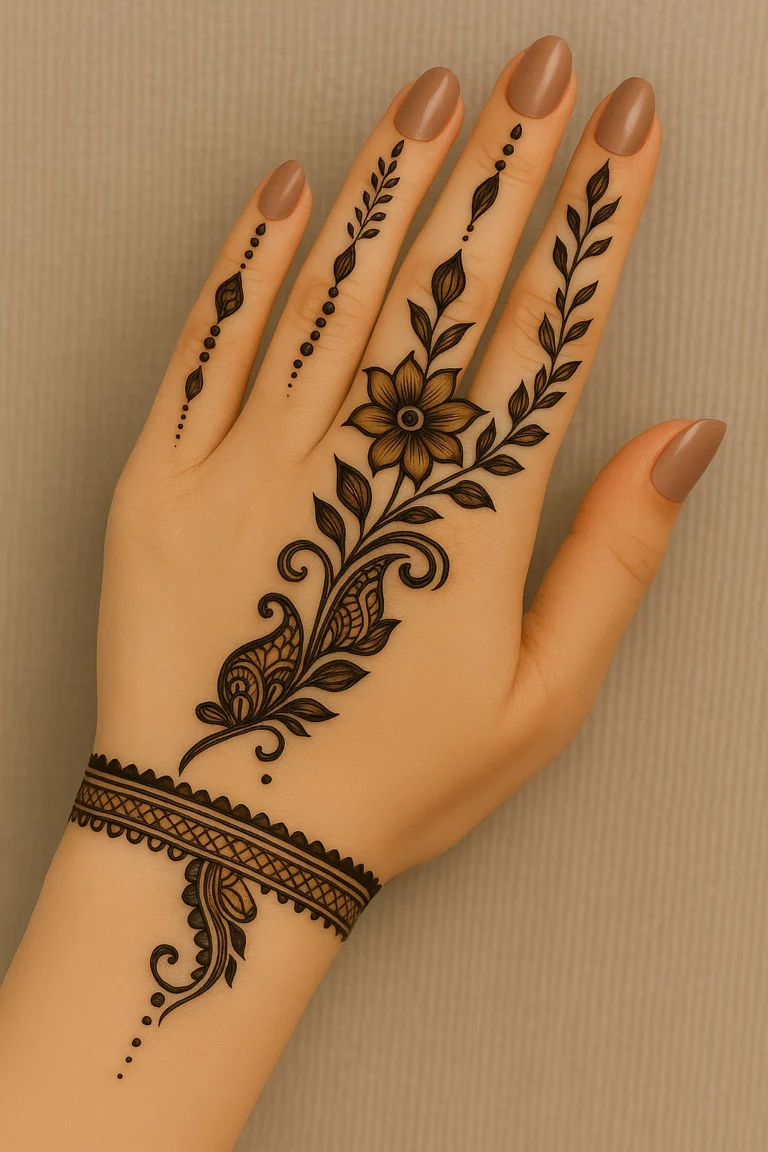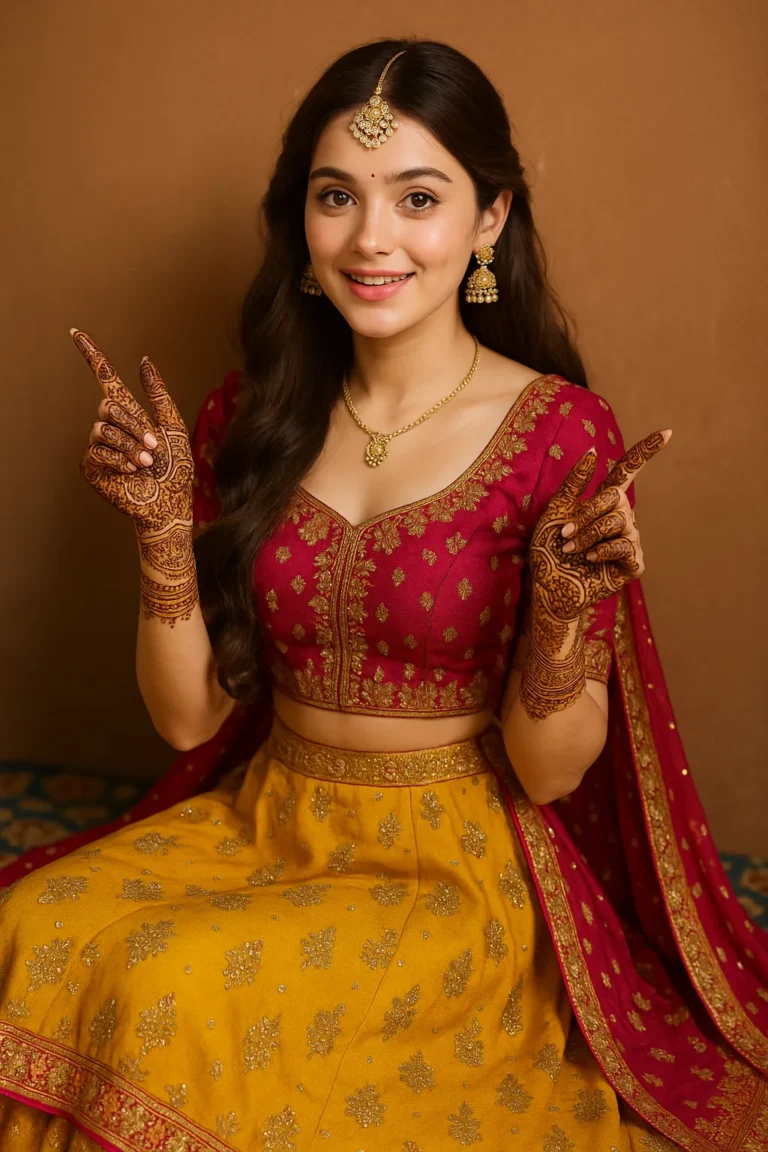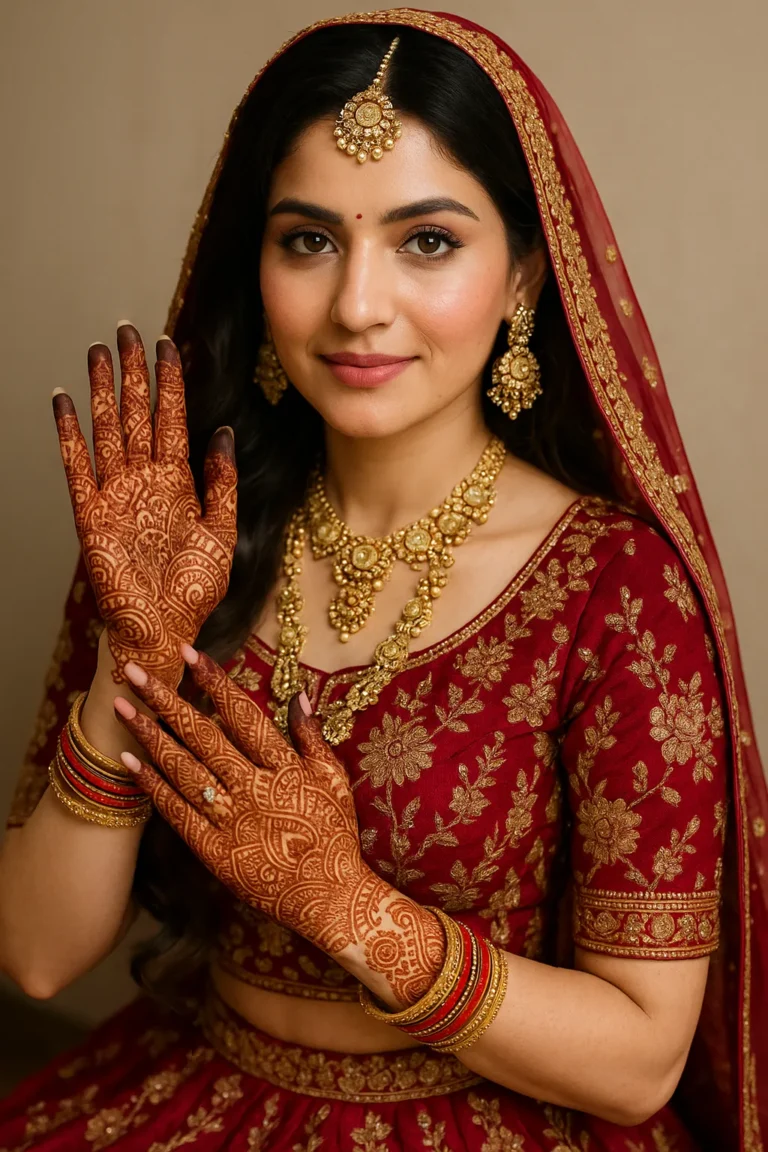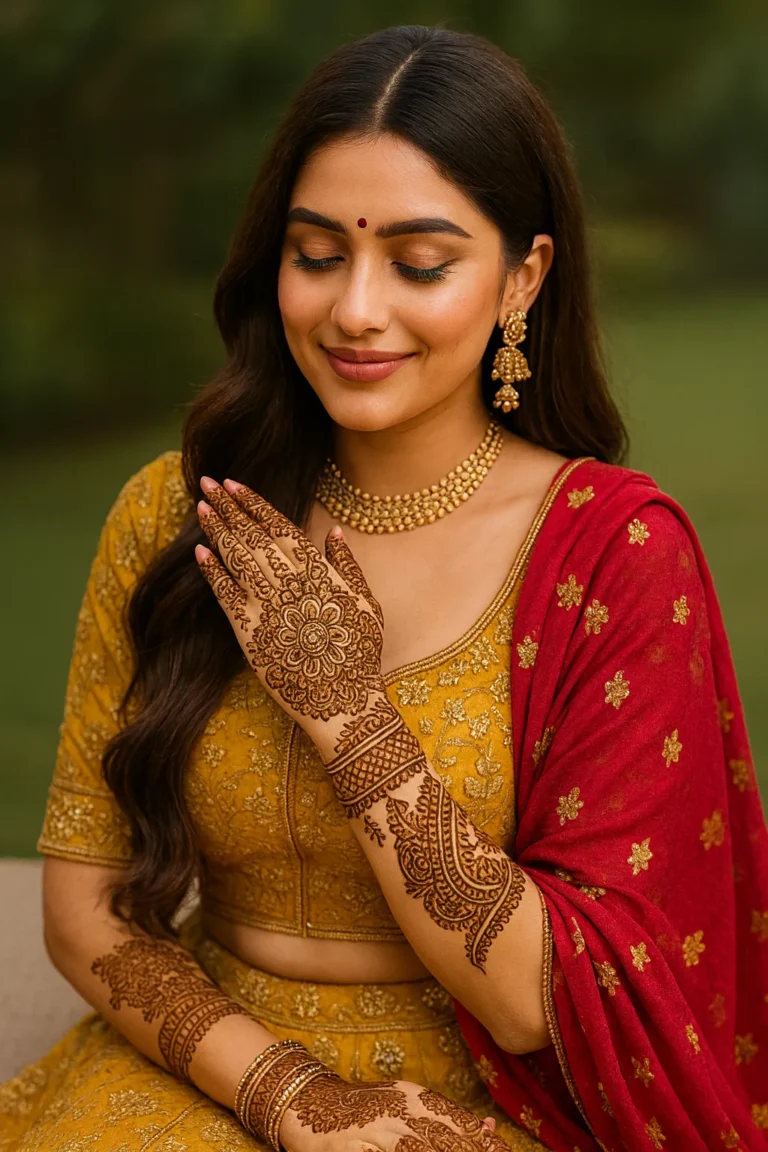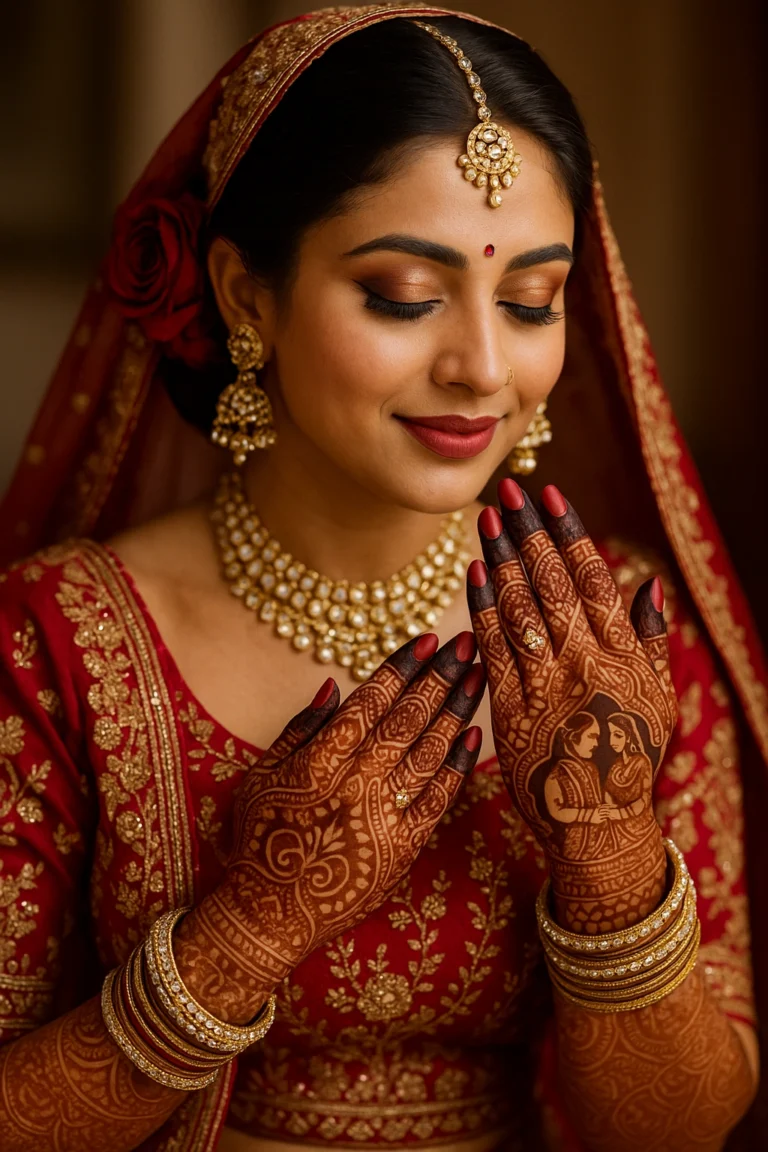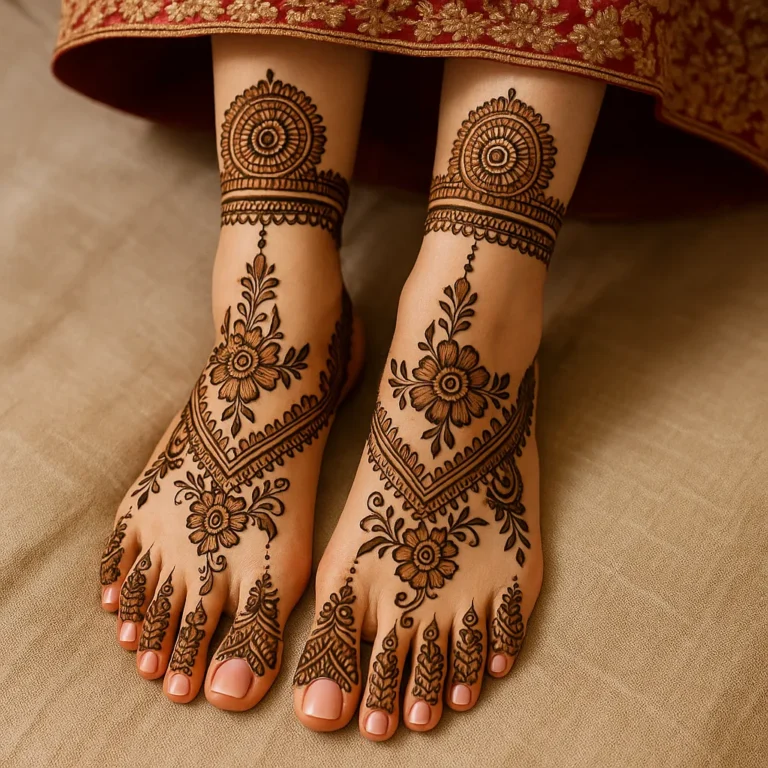More Than Mehndi, A Silent Jewel
There’s something sacred about the moment a bride looks down at her hands and sees more than just patterns — she sees memories. She sees emotion. She sees herself.
In 2025, while the world of mehndi continues to flourish with intricate paisleys, florals, and geometric grids, one trend is quietly tugging at the hearts of brides and artists alike — Jewelry-Inspired Mehndi. But this is no passing style. This is art imitating emotion. And for many women, it has become the invisible jewelry of the soul.
The Emotional Origins of Jewelry-Inspired Mehndi
Jewelry has never been just an accessory in South Asian culture. It’s a language. A mother’s gold bangle passed down is not just metal — it’s a blessing. A mangalsutra isn’t just a chain — it’s a lifetime vow. Jewelry tells stories that sometimes words can’t.
Now imagine etching that same story directly onto your skin with mehndi.
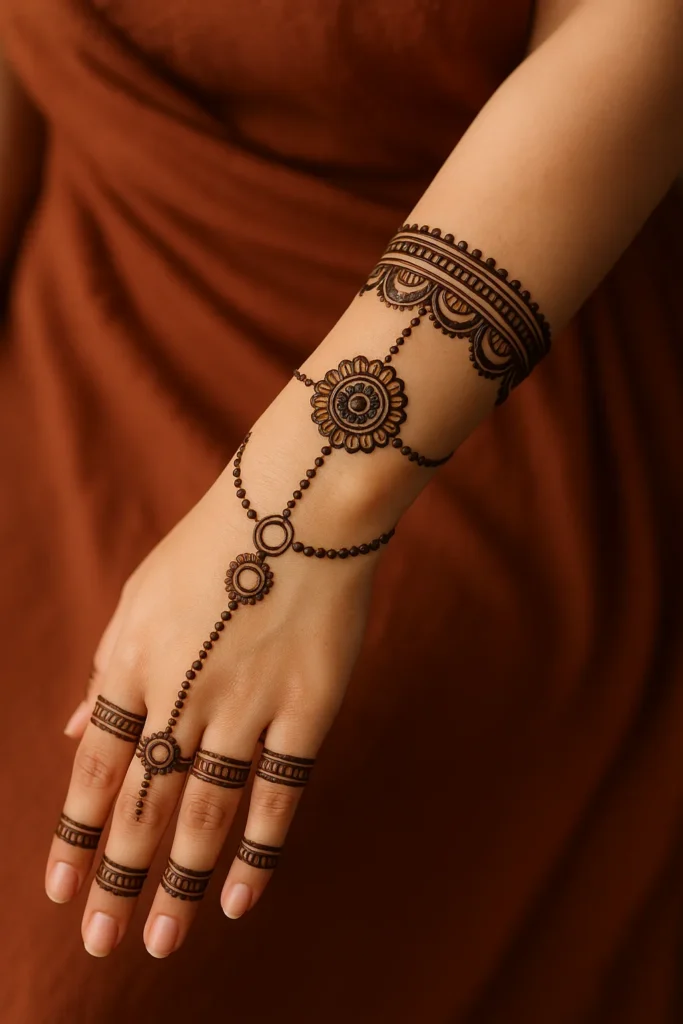
That’s where jewelry-inspired mehndi finds its heart.
It’s not just about design—it’s about wearing memories, even if the gold is missing. It’s about making sure your grandmother’s pearls, your mother’s bangles, and your own feelings are drawn right onto your palms, immortalized in henna.
Why Brides Are Choosing This Style
Brides today are no longer following trends blindly. They’re choosing emotion, meaning, and personalization over everything else. Jewelry-inspired mehndi feels intimate, intentional, and deeply beautiful — both to wear and to photograph.
Here are just a few reasons why brides love this design style:
Read More: Tattoo-Style Mehndi Designs – When Henna Meets Edgy Fashion
- It looks like actual ornaments, enhancing bridal photos without overwhelming them.
- It can replace real jewelry for minimalist or budget-conscious brides.
- It connects to memory — many brides incorporate designs inspired by heirlooms.
- It’s timeless — blending modern artistry with cultural symbolism.
- It allows for creative storytelling, hidden messages, and custom motifs.
Real-Life Stories That Bring It to Life
Let me tell you about Tanya, a bride from Amritsar. Her nani used to wear a unique haathphool with tiny ghungroos that jingled every time she moved her hand. Tanya lost her nani a year before her wedding. During her bridal mehndi, she requested her artist to recreate that same haathphool in mehndi, down to the bell shapes and delicate chains.
She cried quietly while it was being drawn. “I know nani’s not here,” she said, “but this makes it feel like she’s blessing me.”
That is the power of this style.
In another instance, Rupal, a bride from Pune, had to cancel her destination wedding due to unforeseen circumstances. She wore no jewelry, no designer lehenga. But her mehndi — a graceful mix of bangles, anklets, and jhumka-style motifs — made her feel like royalty. “My mehndi was my only jewelry,” she smiled, “and it meant more than diamonds.”
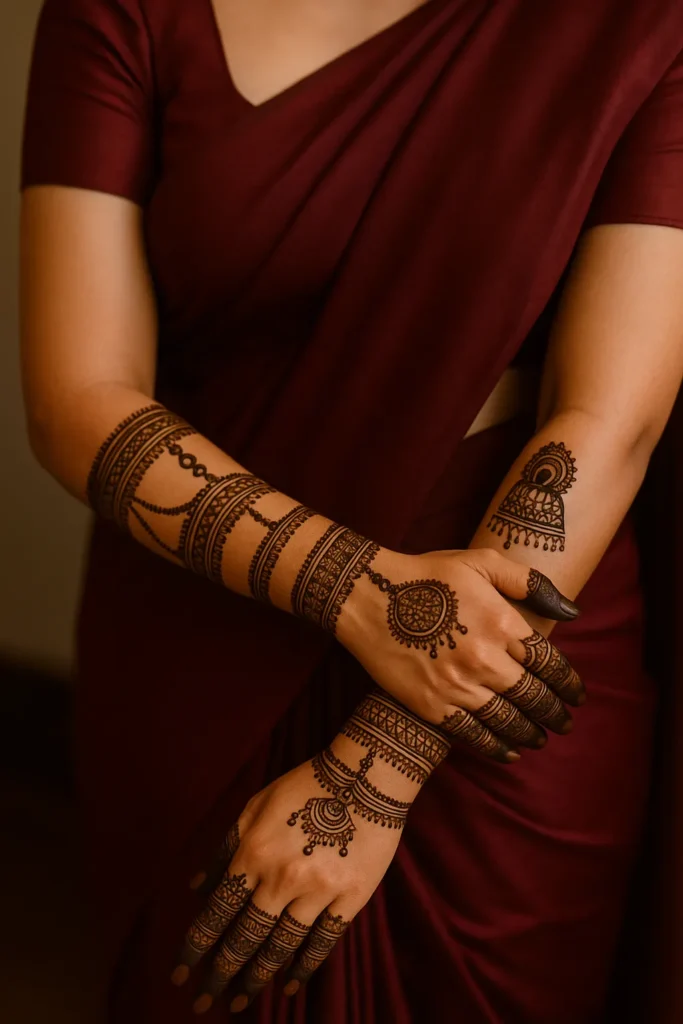
Elements That Define Jewelry-Inspired Mehndi
Let’s explore the common elements artists use to turn mehndi into metaphorical ornaments:
1. Haathphool Illusions
These designs usually start from the center of the palm with a floral motif and extend into lines and chains leading to each finger. It looks exactly like the bridal hand harness jewelry (haathphool) worn in weddings.
2. Bangle or Kangan Bands
Concentric circles around the wrist, drawn with symmetry and often layered with mandalas or paisleys, mimic stacked bangles or even kada (thicker bracelets).
3. Ring Motifs
Tiny rings drawn at the base of fingers, often with detailed stone-like centers or bold dots, feel like finger rings — especially when paired with haathphool designs.
4. Anklet & Payal Patterns
Though often on the feet, artists now draw payal-style chains on the wrists or edges of palms too — adding jingling textures using dots and semi-circles.
5. Jhumka-Inspired Elements
Earrings are often a girl’s favorite piece of jewelry — so why not in mehndi too? You’ll see bell-shaped danglers, usually along the side of the palms or as wrist flourishes.
The Artistic Techniques Behind the Illusion
Creating jewelry-inspired mehndi requires patience and technical finesse. Artists often use:
- Spacing: To mimic the gaps between ornaments.
- Dotting: To imitate pearls, bells, or tiny beads.
- Shading: Gives depth and a metallic or stone-studded look.
- Symmetry: Essential for the jewelry look to feel intentional.
- White mehndi or body paint: Often used for shine or ‘stone’ effect, especially in fusion weddings or photoshoots.
Pro tip: Some artists also mix silver glitter mehndi in small areas to reflect light like real jewelry. It doesn’t feel gimmicky when done with balance — it feels magical.
A Design Language for Every Bride
This style is not just for traditional brides. Here’s how it adapts to different bridal personalities:
- The Minimalist Bride: She may skip heavy necklaces and prefer simple gold. A subtle haathphool mehndi design fits her vibe beautifully.
- The Sentimental Bride: She might carry a story—like Tanya did—and turn a memory into mehndi.
- The Glam Bride: She’ll want bold bangles, jhumkas, and shimmer in her henna. The design becomes her main accessory.
- The Fusion Bride: Wearing a saree with sneakers or a gown with jhumkas? Jewelry-inspired mehndi bridges cultures perfectly.
How to Pair It With Your Outfit and Jewelry
Want your mehndi to stand out in your wedding photos? Here’s how to balance it with your look:
- If wearing heavy jewelry: Keep your mehndi lighter and clean. Let it complement, not compete.
- If skipping real jewelry: Go bold with bangle borders and haathphool lines. You’ll glow effortlessly.
- Bright lehengas or pastel sarees: Both pair beautifully with this design—just match the mehndi tone accordingly (deep brown, maroon, or black).
- Pre-wedding shoots: Use this design even if you’re in jeans! It adds an ethnic touch to casual looks.
Message for Artists: This Isn’t Just Design — It’s Emotion
If you’re a mehndi artist reading this, pause and ask yourself:
Are you just drawing? Or are you listening?
Every bride you meet is carrying a hundred emotions. Ask her questions like:
- “Is there a piece of jewelry you wish to remember?”
- “Do you want me to add your mom’s wedding motif?”
- “Do you want your partner’s name hidden in a ring?”
When you draw from her heart, not just your cone, the mehndi will feel like hers, not just art.
Cultural Significance: It’s Not Just Modern – It’s Rooted in Tradition
Some might say this is a new trend, but the truth is — our grandmothers did this long ago, only in a more raw form.
In olden times, women who couldn’t afford gold during festivals would wear mehndi that resembled bangles or anklets. For many, it was the only ornament they had. Today, that same style is coming back — this time with more elegance, more freedom, and a whole lot more meaning.
This isn’t fusion. This is full circle.
Emotional Anchor: When the Stain Fades, the Story Remains
Bridal mehndi fades. That’s the truth. But what remains is the feeling it left behind.
When a bride remembers her wedding, it’s not just about how red the stain was — it’s about what was drawn, why it was drawn, and what it meant to her.
And that is what makes jewelry-inspired mehndi timeless. The stain may fade in a week, but the memory? That lingers for a lifetime.
Final Words: Wear Your Emotions
In 2025, trends will come and go. But meaningful art stays.
So whether you’re a bride, a bridesmaid, or someone who just loves mehndi — don’t follow a Pinterest board blindly. Let your design reflect you.
If your hands could talk, what would they say?
Let them whisper your mother’s lullabies, your grandmother’s traditions, your own fire, and your quiet love. Let them wear your story like jewelry. Because after all, isn’t that what mehndi truly is — an emotion worn proudly on the skin?
